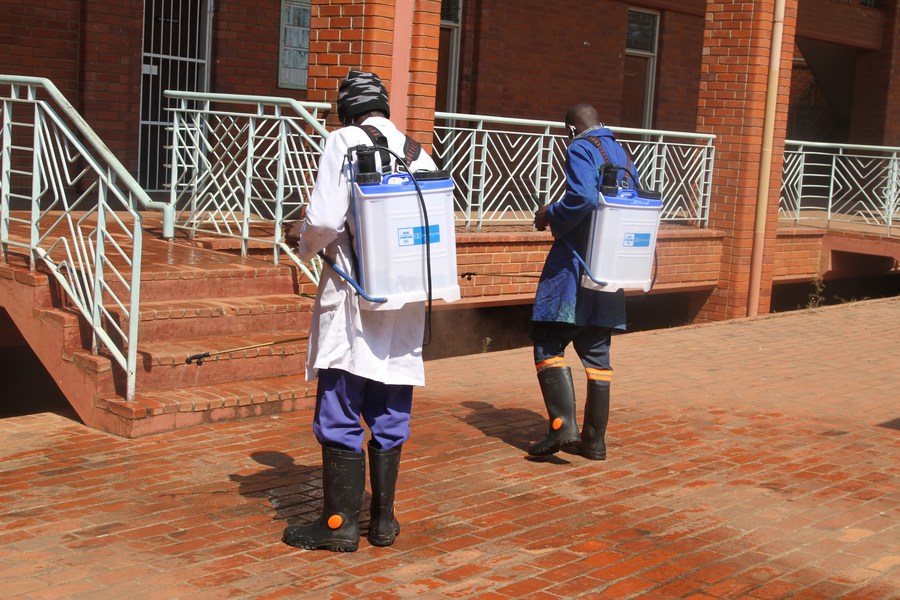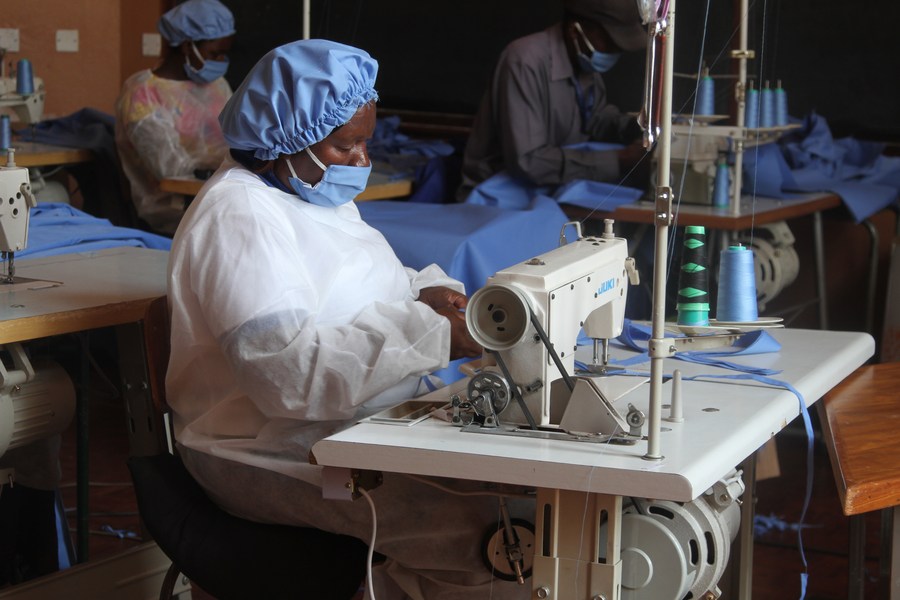
The photo shows a student working at a hand sanitizer manufacturing station at the University of Zimbabwe in Harare, Zimbabwe, Sept. 22, 2020. (Xinhua/Tafara Mugwara)
The University of Zimbabwe is playing a vital role in helping to respond to a shortage of hand sanitizers and Personal Protective Equipment needed to prevent the spread of COVID-19.
HARARE, Sept. 27 (Xinhua) -- The University of Zimbabwe is playing a vital role in helping to respond to a shortage of hand sanitizers and Personal Protective Equipment (PPE) needed to prevent the spread of COVID-19.
Production of hand sanitizers by Zimbabwe's premier and oldest university kicked off at the onset of the pandemic in March in response to government's call for local institutions of higher learning to create solutions to the country's challenges.
The government made available an initial 1.3 million U.S. dollars in seed capital to institutions with engineering and technical capacity to make PPEs needed to address a national shortage.
Bringing together technical expertise across a broad range of disciplines, the university is now producing about 60,000 liters of hand sanitizer a day, with the number expected to increase as new measures to rump up production are being put in place.
Obert Jiri, the Coordinator in the Sanitizer and PPE production, said the university has made a significant contribution in plugging the shortage of anti COVID-19 materials in the country.

Workers fumigate offices at the University of Zimbabwe to combat the spread of COVID-19 in Harare, Zimbabwe, Sept. 22, 2020. (Xinhua/Tafara Mugwara)
"We have contributed quite a bit to the fight against COVID-19, I think we move at least two truckloads of sanitizers and disinfectants, we move quite a bit of masks and also the hospital gowns and other PPEs that are used," he said.
The university produces a minimum of 5,000 masks a day and has also utilized its students to contribute in terms of technical expertise and in the production of PPEs.
The initiative dovetails with government efforts to shift focus from producing employment seeking university graduates into producing entrepreneurs that can help improve industrial production and create employment.
Previously, the education system in Zimbabwe, which was rated as Higher and Tertiary Education 3.0, focused more on teaching, research and community service. A newly adopted model, HTE 5.0 focuses on problem solving and value creation.
Jiri said in line with HTE 5.0, the university has moved from teaching, community service and writing papers into innovation and industrialization.
"So what you have seen here and what we produce are really products of our intellectual prowess within the university, the formulations that we have of the sanitizers, of the detergents, the designs that we have of the masks, of various PPEs, so these were things that were generally there in terms of intellectual knowledge and prowess, but now we have moved from just having knowledge in books and textbooks and papers into tangible goods and services which you will see here and which we now produce," he said.

Workers make surgical gowns used by frontline medical workers in the fight against COVID-19 at the University of Zimbabwe in Harare, Zimbabwe, Sept. 22, 2020. (Xinhua/Tafara Mugwara)
Jiri said early fruits of the shift in focus was the technical expertise that the university has made towards mitigating against the COVID-19 pandemic.
Besides providing desperately needed materials for the prevention of the coronavirus, the initiative has now fully gone commercial.
"So we are not going to stop here, we are not going to stop with COVID-19. That's why you find that our products range is not only based on sanitizers, disinfectants and PPEs, but we have moved into hand washing, into liquid soaps, including work suits and so forth so that we are an industry that produces various goods and services," he said.
Jiri said the commercialization of education to make the institution self-sustainable was already in the cards long before the pandemic.
Mavis Rufaro Chikoore, a lecturer in the Department of Textiles Engineering and also a project manager, said the production for PPEs started as a way of plugging a shortage gap in the advent of the pandemic.
"We started off with face masks, we could not produce the disposable ones because we don't have the machinery, but with the knowledge of textiles engineering, we started off producing the reusable ones, and we found these of great importance to our nation in that they were not just used once and thrown away, they can be used several times, and they are washable and they are affordable as compared to the imported disposable ones," she said.

Obert Jiri (R), the Coordinator in the Sanitizer and PPE production at Zimbabwe, speaks at the University of Zimbabwe in Harare, Zimbabwe, Sept. 22, 2020. (Xinhua/Tafara Mugwara)
Chikoore said the local demand of PPEs remain high, and currently, the university is making 23 different types of PPEs which include face masks, theater caps, theater gowns, gloves and overshoes.
To date the university has produced over 400,000 face masks, about a million theater caps, and tens of thousands of theater gowns.
Chikoore said the major take-away from the efforts being done by the university is that it is possible for local industries to produce goods and services instead of entirely relying on imports.
The government believes institutions of higher learning play a pivotal role in building a knowledge-based economy required to spearhead its efforts to transform Zimbabwe into an upper-middle-income society by 2030.
The country has already made giant strides in line with that vision by setting up innovation hubs across the country's major tertiary institutions which will support research and development of concepts that can then be put into use in resuscitating the country's industry.



